Intelligent Transportation System: Applications, Benefits, and Solutions
VerifiedAdded on 2023/01/11
|11
|3401
|26
AI Summary
This report provides an in-depth insight into intelligent transportation systems, their benefits, applications, and solutions to the problems associated with them. It discusses the concept of transport engineering and the application of intelligent transportation systems in different countries. It also highlights the benefits of ITS, such as improved traffic safety, minimized infrastructure damage, and efficient traffic control. Additionally, it addresses the problems faced by ITS, including security and privacy issues, and provides potential solutions. The report concludes with a discussion on the use of big data in intelligent transportation systems.
Contribute Materials
Your contribution can guide someone’s learning journey. Share your
documents today.
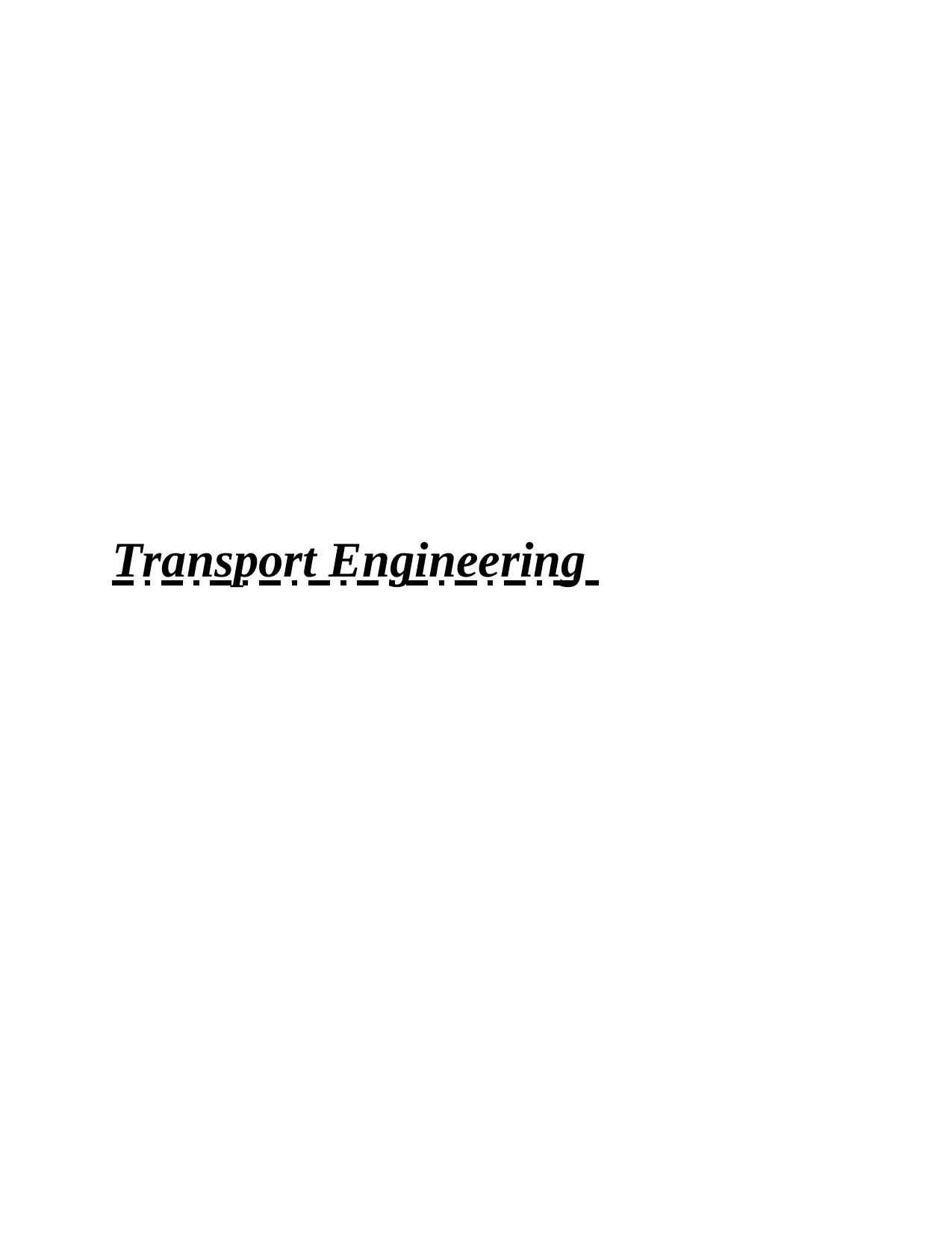
Transport Engineering
Secure Best Marks with AI Grader
Need help grading? Try our AI Grader for instant feedback on your assignments.
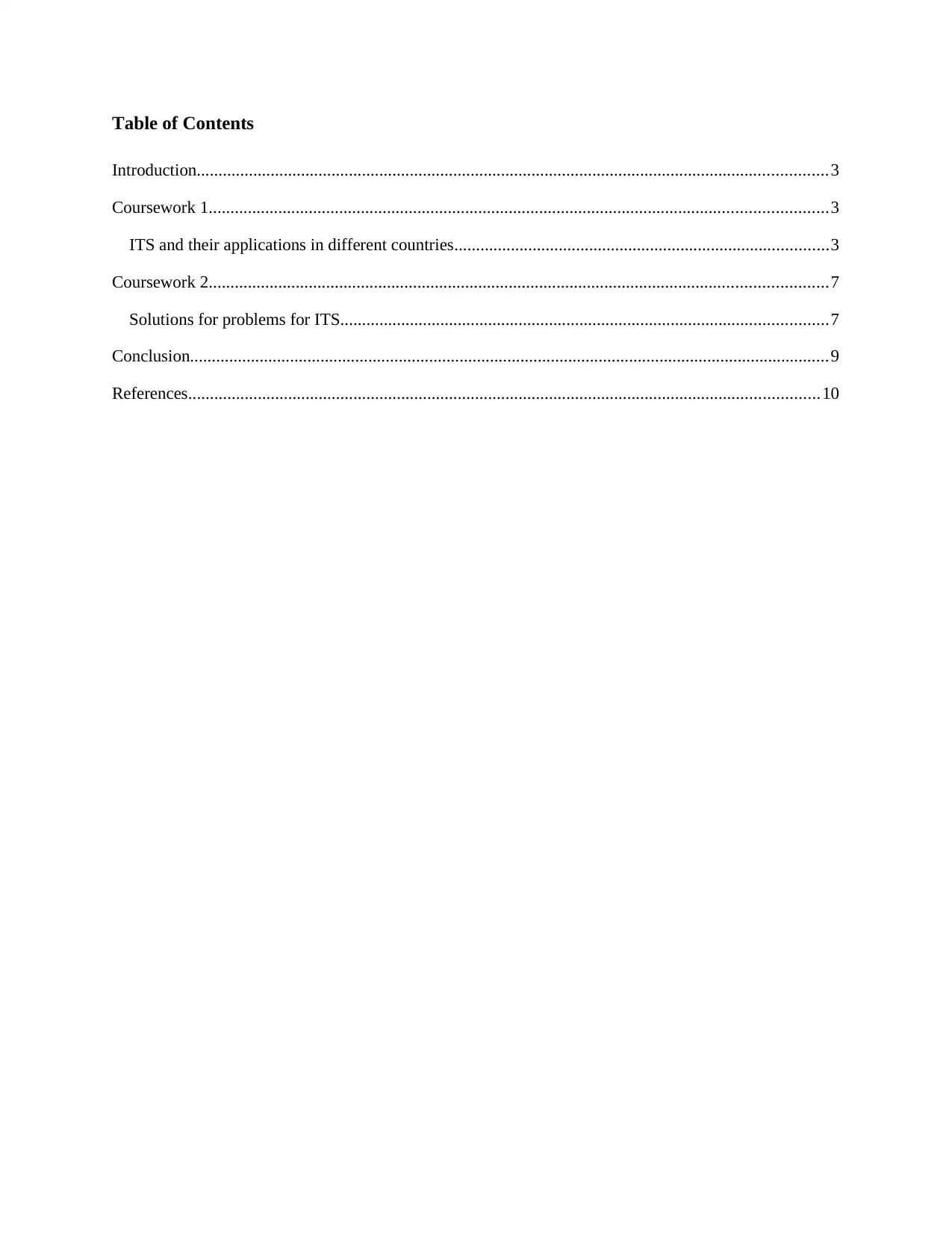
Table of Contents
Introduction.................................................................................................................................................3
Coursework 1..............................................................................................................................................3
ITS and their applications in different countries......................................................................................3
Coursework 2..............................................................................................................................................7
Solutions for problems for ITS................................................................................................................7
Conclusion...................................................................................................................................................9
References.................................................................................................................................................10
Introduction.................................................................................................................................................3
Coursework 1..............................................................................................................................................3
ITS and their applications in different countries......................................................................................3
Coursework 2..............................................................................................................................................7
Solutions for problems for ITS................................................................................................................7
Conclusion...................................................................................................................................................9
References.................................................................................................................................................10
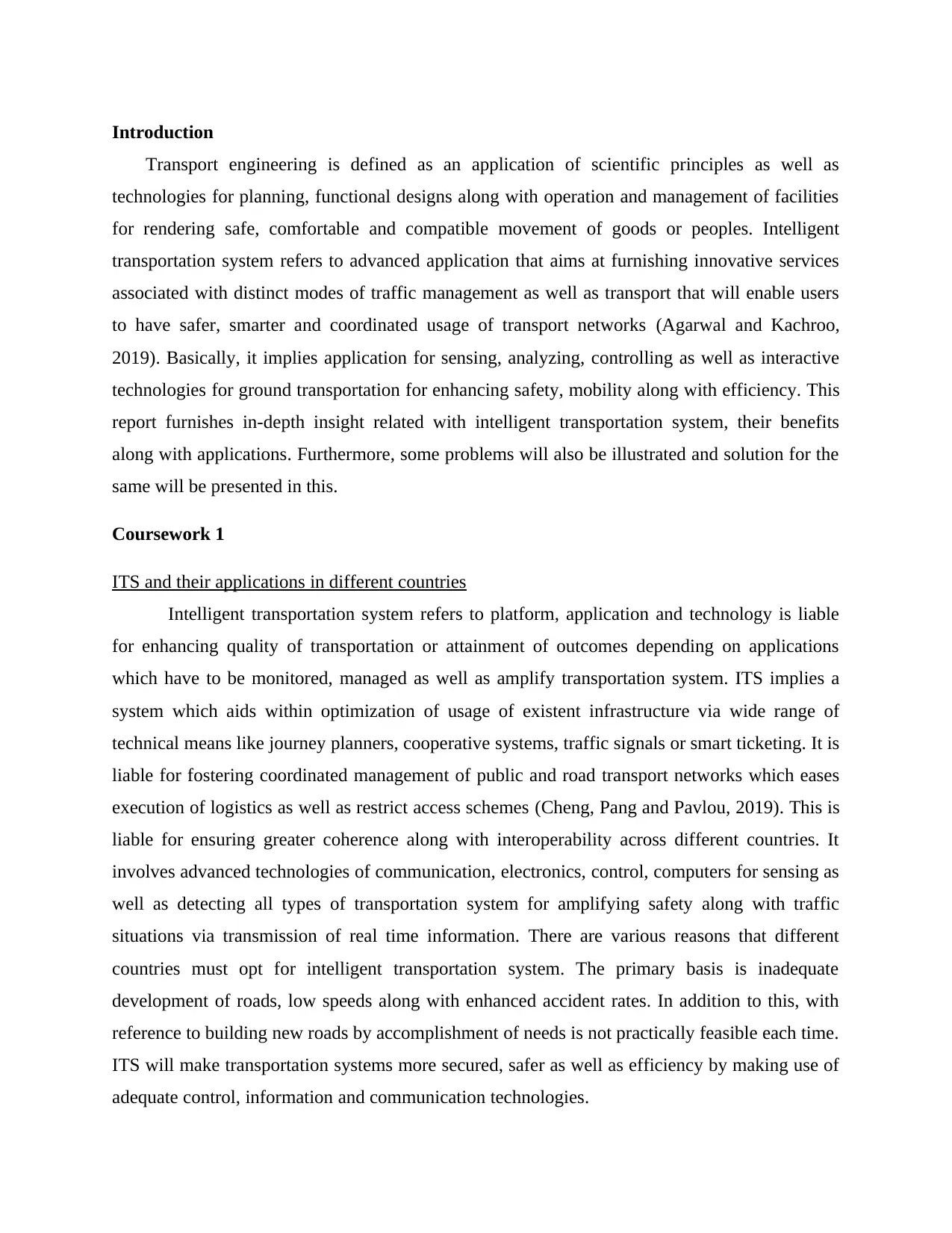
Introduction
Transport engineering is defined as an application of scientific principles as well as
technologies for planning, functional designs along with operation and management of facilities
for rendering safe, comfortable and compatible movement of goods or peoples. Intelligent
transportation system refers to advanced application that aims at furnishing innovative services
associated with distinct modes of traffic management as well as transport that will enable users
to have safer, smarter and coordinated usage of transport networks (Agarwal and Kachroo,
2019). Basically, it implies application for sensing, analyzing, controlling as well as interactive
technologies for ground transportation for enhancing safety, mobility along with efficiency. This
report furnishes in-depth insight related with intelligent transportation system, their benefits
along with applications. Furthermore, some problems will also be illustrated and solution for the
same will be presented in this.
Coursework 1
ITS and their applications in different countries
Intelligent transportation system refers to platform, application and technology is liable
for enhancing quality of transportation or attainment of outcomes depending on applications
which have to be monitored, managed as well as amplify transportation system. ITS implies a
system which aids within optimization of usage of existent infrastructure via wide range of
technical means like journey planners, cooperative systems, traffic signals or smart ticketing. It is
liable for fostering coordinated management of public and road transport networks which eases
execution of logistics as well as restrict access schemes (Cheng, Pang and Pavlou, 2019). This is
liable for ensuring greater coherence along with interoperability across different countries. It
involves advanced technologies of communication, electronics, control, computers for sensing as
well as detecting all types of transportation system for amplifying safety along with traffic
situations via transmission of real time information. There are various reasons that different
countries must opt for intelligent transportation system. The primary basis is inadequate
development of roads, low speeds along with enhanced accident rates. In addition to this, with
reference to building new roads by accomplishment of needs is not practically feasible each time.
ITS will make transportation systems more secured, safer as well as efficiency by making use of
adequate control, information and communication technologies.
Transport engineering is defined as an application of scientific principles as well as
technologies for planning, functional designs along with operation and management of facilities
for rendering safe, comfortable and compatible movement of goods or peoples. Intelligent
transportation system refers to advanced application that aims at furnishing innovative services
associated with distinct modes of traffic management as well as transport that will enable users
to have safer, smarter and coordinated usage of transport networks (Agarwal and Kachroo,
2019). Basically, it implies application for sensing, analyzing, controlling as well as interactive
technologies for ground transportation for enhancing safety, mobility along with efficiency. This
report furnishes in-depth insight related with intelligent transportation system, their benefits
along with applications. Furthermore, some problems will also be illustrated and solution for the
same will be presented in this.
Coursework 1
ITS and their applications in different countries
Intelligent transportation system refers to platform, application and technology is liable
for enhancing quality of transportation or attainment of outcomes depending on applications
which have to be monitored, managed as well as amplify transportation system. ITS implies a
system which aids within optimization of usage of existent infrastructure via wide range of
technical means like journey planners, cooperative systems, traffic signals or smart ticketing. It is
liable for fostering coordinated management of public and road transport networks which eases
execution of logistics as well as restrict access schemes (Cheng, Pang and Pavlou, 2019). This is
liable for ensuring greater coherence along with interoperability across different countries. It
involves advanced technologies of communication, electronics, control, computers for sensing as
well as detecting all types of transportation system for amplifying safety along with traffic
situations via transmission of real time information. There are various reasons that different
countries must opt for intelligent transportation system. The primary basis is inadequate
development of roads, low speeds along with enhanced accident rates. In addition to this, with
reference to building new roads by accomplishment of needs is not practically feasible each time.
ITS will make transportation systems more secured, safer as well as efficiency by making use of
adequate control, information and communication technologies.
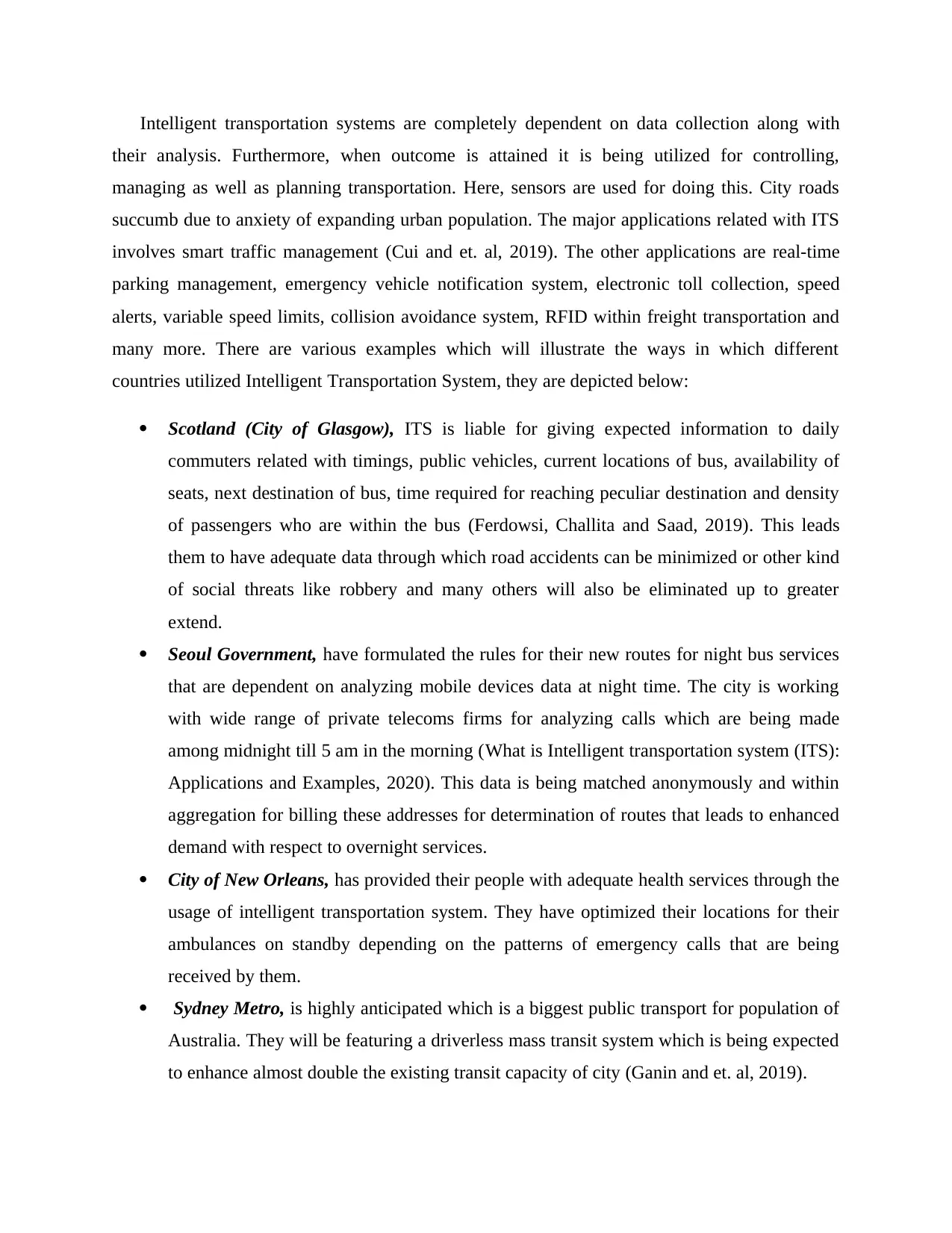
Intelligent transportation systems are completely dependent on data collection along with
their analysis. Furthermore, when outcome is attained it is being utilized for controlling,
managing as well as planning transportation. Here, sensors are used for doing this. City roads
succumb due to anxiety of expanding urban population. The major applications related with ITS
involves smart traffic management (Cui and et. al, 2019). The other applications are real-time
parking management, emergency vehicle notification system, electronic toll collection, speed
alerts, variable speed limits, collision avoidance system, RFID within freight transportation and
many more. There are various examples which will illustrate the ways in which different
countries utilized Intelligent Transportation System, they are depicted below:
Scotland (City of Glasgow), ITS is liable for giving expected information to daily
commuters related with timings, public vehicles, current locations of bus, availability of
seats, next destination of bus, time required for reaching peculiar destination and density
of passengers who are within the bus (Ferdowsi, Challita and Saad, 2019). This leads
them to have adequate data through which road accidents can be minimized or other kind
of social threats like robbery and many others will also be eliminated up to greater
extend.
Seoul Government, have formulated the rules for their new routes for night bus services
that are dependent on analyzing mobile devices data at night time. The city is working
with wide range of private telecoms firms for analyzing calls which are being made
among midnight till 5 am in the morning (What is Intelligent transportation system (ITS):
Applications and Examples, 2020). This data is being matched anonymously and within
aggregation for billing these addresses for determination of routes that leads to enhanced
demand with respect to overnight services.
City of New Orleans, has provided their people with adequate health services through the
usage of intelligent transportation system. They have optimized their locations for their
ambulances on standby depending on the patterns of emergency calls that are being
received by them.
Sydney Metro, is highly anticipated which is a biggest public transport for population of
Australia. They will be featuring a driverless mass transit system which is being expected
to enhance almost double the existing transit capacity of city (Ganin and et. al, 2019).
their analysis. Furthermore, when outcome is attained it is being utilized for controlling,
managing as well as planning transportation. Here, sensors are used for doing this. City roads
succumb due to anxiety of expanding urban population. The major applications related with ITS
involves smart traffic management (Cui and et. al, 2019). The other applications are real-time
parking management, emergency vehicle notification system, electronic toll collection, speed
alerts, variable speed limits, collision avoidance system, RFID within freight transportation and
many more. There are various examples which will illustrate the ways in which different
countries utilized Intelligent Transportation System, they are depicted below:
Scotland (City of Glasgow), ITS is liable for giving expected information to daily
commuters related with timings, public vehicles, current locations of bus, availability of
seats, next destination of bus, time required for reaching peculiar destination and density
of passengers who are within the bus (Ferdowsi, Challita and Saad, 2019). This leads
them to have adequate data through which road accidents can be minimized or other kind
of social threats like robbery and many others will also be eliminated up to greater
extend.
Seoul Government, have formulated the rules for their new routes for night bus services
that are dependent on analyzing mobile devices data at night time. The city is working
with wide range of private telecoms firms for analyzing calls which are being made
among midnight till 5 am in the morning (What is Intelligent transportation system (ITS):
Applications and Examples, 2020). This data is being matched anonymously and within
aggregation for billing these addresses for determination of routes that leads to enhanced
demand with respect to overnight services.
City of New Orleans, has provided their people with adequate health services through the
usage of intelligent transportation system. They have optimized their locations for their
ambulances on standby depending on the patterns of emergency calls that are being
received by them.
Sydney Metro, is highly anticipated which is a biggest public transport for population of
Australia. They will be featuring a driverless mass transit system which is being expected
to enhance almost double the existing transit capacity of city (Ganin and et. al, 2019).
Secure Best Marks with AI Grader
Need help grading? Try our AI Grader for instant feedback on your assignments.
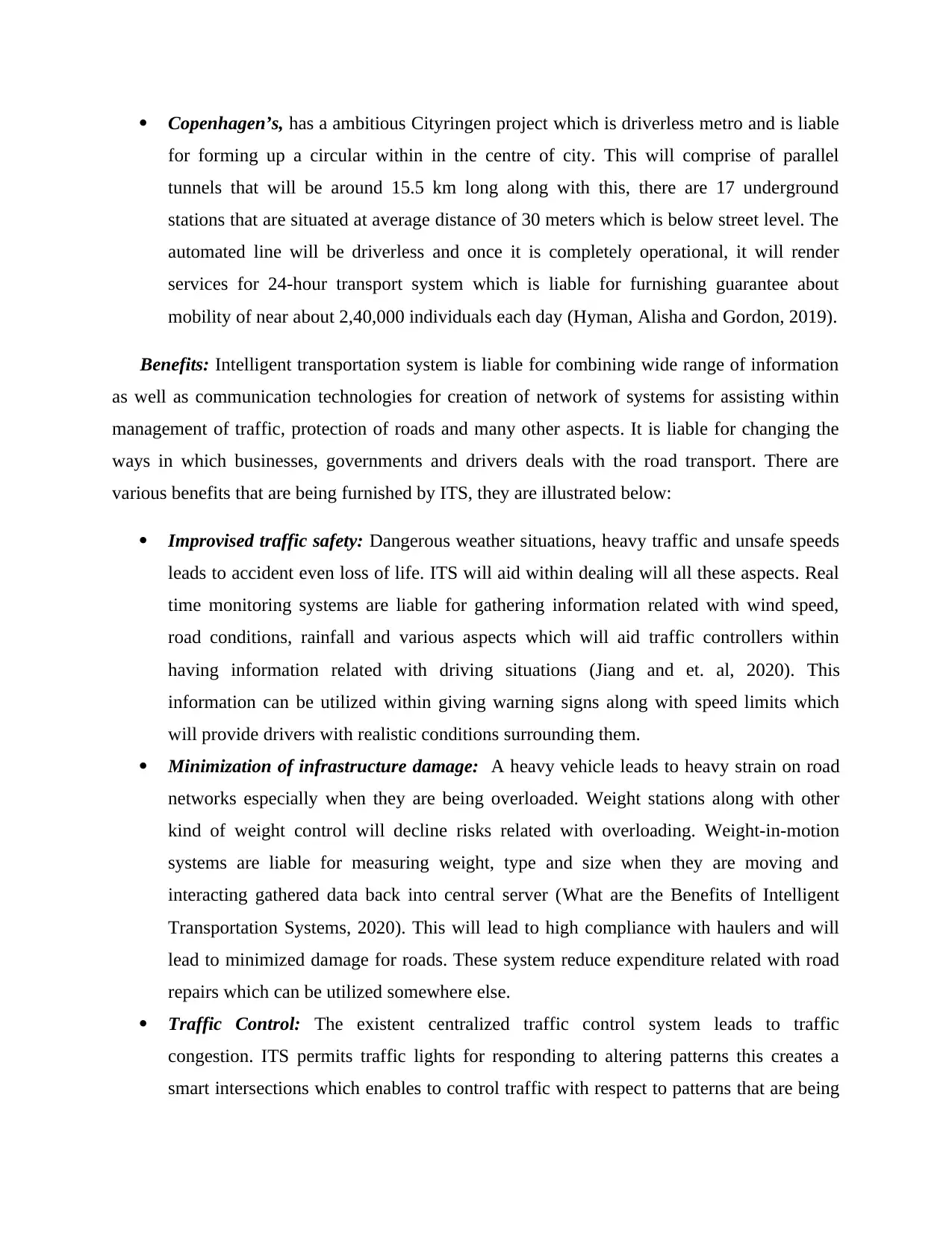
Copenhagen’s, has a ambitious Cityringen project which is driverless metro and is liable
for forming up a circular within in the centre of city. This will comprise of parallel
tunnels that will be around 15.5 km long along with this, there are 17 underground
stations that are situated at average distance of 30 meters which is below street level. The
automated line will be driverless and once it is completely operational, it will render
services for 24-hour transport system which is liable for furnishing guarantee about
mobility of near about 2,40,000 individuals each day (Hyman, Alisha and Gordon, 2019).
Benefits: Intelligent transportation system is liable for combining wide range of information
as well as communication technologies for creation of network of systems for assisting within
management of traffic, protection of roads and many other aspects. It is liable for changing the
ways in which businesses, governments and drivers deals with the road transport. There are
various benefits that are being furnished by ITS, they are illustrated below:
Improvised traffic safety: Dangerous weather situations, heavy traffic and unsafe speeds
leads to accident even loss of life. ITS will aid within dealing will all these aspects. Real
time monitoring systems are liable for gathering information related with wind speed,
road conditions, rainfall and various aspects which will aid traffic controllers within
having information related with driving situations (Jiang and et. al, 2020). This
information can be utilized within giving warning signs along with speed limits which
will provide drivers with realistic conditions surrounding them.
Minimization of infrastructure damage: A heavy vehicle leads to heavy strain on road
networks especially when they are being overloaded. Weight stations along with other
kind of weight control will decline risks related with overloading. Weight-in-motion
systems are liable for measuring weight, type and size when they are moving and
interacting gathered data back into central server (What are the Benefits of Intelligent
Transportation Systems, 2020). This will lead to high compliance with haulers and will
lead to minimized damage for roads. These system reduce expenditure related with road
repairs which can be utilized somewhere else.
Traffic Control: The existent centralized traffic control system leads to traffic
congestion. ITS permits traffic lights for responding to altering patterns this creates a
smart intersections which enables to control traffic with respect to patterns that are being
for forming up a circular within in the centre of city. This will comprise of parallel
tunnels that will be around 15.5 km long along with this, there are 17 underground
stations that are situated at average distance of 30 meters which is below street level. The
automated line will be driverless and once it is completely operational, it will render
services for 24-hour transport system which is liable for furnishing guarantee about
mobility of near about 2,40,000 individuals each day (Hyman, Alisha and Gordon, 2019).
Benefits: Intelligent transportation system is liable for combining wide range of information
as well as communication technologies for creation of network of systems for assisting within
management of traffic, protection of roads and many other aspects. It is liable for changing the
ways in which businesses, governments and drivers deals with the road transport. There are
various benefits that are being furnished by ITS, they are illustrated below:
Improvised traffic safety: Dangerous weather situations, heavy traffic and unsafe speeds
leads to accident even loss of life. ITS will aid within dealing will all these aspects. Real
time monitoring systems are liable for gathering information related with wind speed,
road conditions, rainfall and various aspects which will aid traffic controllers within
having information related with driving situations (Jiang and et. al, 2020). This
information can be utilized within giving warning signs along with speed limits which
will provide drivers with realistic conditions surrounding them.
Minimization of infrastructure damage: A heavy vehicle leads to heavy strain on road
networks especially when they are being overloaded. Weight stations along with other
kind of weight control will decline risks related with overloading. Weight-in-motion
systems are liable for measuring weight, type and size when they are moving and
interacting gathered data back into central server (What are the Benefits of Intelligent
Transportation Systems, 2020). This will lead to high compliance with haulers and will
lead to minimized damage for roads. These system reduce expenditure related with road
repairs which can be utilized somewhere else.
Traffic Control: The existent centralized traffic control system leads to traffic
congestion. ITS permits traffic lights for responding to altering patterns this creates a
smart intersections which enables to control traffic with respect to patterns that are being
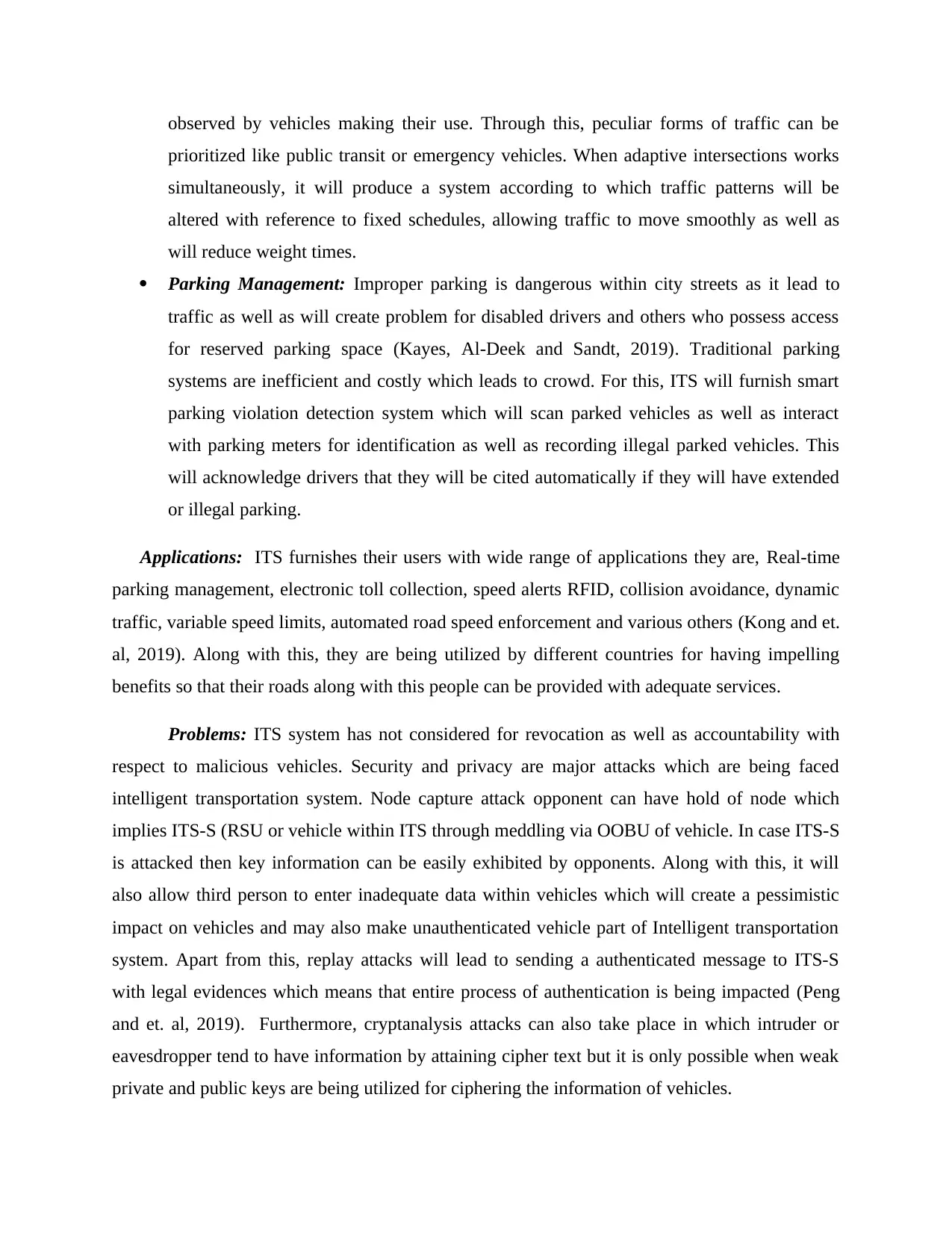
observed by vehicles making their use. Through this, peculiar forms of traffic can be
prioritized like public transit or emergency vehicles. When adaptive intersections works
simultaneously, it will produce a system according to which traffic patterns will be
altered with reference to fixed schedules, allowing traffic to move smoothly as well as
will reduce weight times.
Parking Management: Improper parking is dangerous within city streets as it lead to
traffic as well as will create problem for disabled drivers and others who possess access
for reserved parking space (Kayes, Al-Deek and Sandt, 2019). Traditional parking
systems are inefficient and costly which leads to crowd. For this, ITS will furnish smart
parking violation detection system which will scan parked vehicles as well as interact
with parking meters for identification as well as recording illegal parked vehicles. This
will acknowledge drivers that they will be cited automatically if they will have extended
or illegal parking.
Applications: ITS furnishes their users with wide range of applications they are, Real-time
parking management, electronic toll collection, speed alerts RFID, collision avoidance, dynamic
traffic, variable speed limits, automated road speed enforcement and various others (Kong and et.
al, 2019). Along with this, they are being utilized by different countries for having impelling
benefits so that their roads along with this people can be provided with adequate services.
Problems: ITS system has not considered for revocation as well as accountability with
respect to malicious vehicles. Security and privacy are major attacks which are being faced
intelligent transportation system. Node capture attack opponent can have hold of node which
implies ITS-S (RSU or vehicle within ITS through meddling via OOBU of vehicle. In case ITS-S
is attacked then key information can be easily exhibited by opponents. Along with this, it will
also allow third person to enter inadequate data within vehicles which will create a pessimistic
impact on vehicles and may also make unauthenticated vehicle part of Intelligent transportation
system. Apart from this, replay attacks will lead to sending a authenticated message to ITS-S
with legal evidences which means that entire process of authentication is being impacted (Peng
and et. al, 2019). Furthermore, cryptanalysis attacks can also take place in which intruder or
eavesdropper tend to have information by attaining cipher text but it is only possible when weak
private and public keys are being utilized for ciphering the information of vehicles.
prioritized like public transit or emergency vehicles. When adaptive intersections works
simultaneously, it will produce a system according to which traffic patterns will be
altered with reference to fixed schedules, allowing traffic to move smoothly as well as
will reduce weight times.
Parking Management: Improper parking is dangerous within city streets as it lead to
traffic as well as will create problem for disabled drivers and others who possess access
for reserved parking space (Kayes, Al-Deek and Sandt, 2019). Traditional parking
systems are inefficient and costly which leads to crowd. For this, ITS will furnish smart
parking violation detection system which will scan parked vehicles as well as interact
with parking meters for identification as well as recording illegal parked vehicles. This
will acknowledge drivers that they will be cited automatically if they will have extended
or illegal parking.
Applications: ITS furnishes their users with wide range of applications they are, Real-time
parking management, electronic toll collection, speed alerts RFID, collision avoidance, dynamic
traffic, variable speed limits, automated road speed enforcement and various others (Kong and et.
al, 2019). Along with this, they are being utilized by different countries for having impelling
benefits so that their roads along with this people can be provided with adequate services.
Problems: ITS system has not considered for revocation as well as accountability with
respect to malicious vehicles. Security and privacy are major attacks which are being faced
intelligent transportation system. Node capture attack opponent can have hold of node which
implies ITS-S (RSU or vehicle within ITS through meddling via OOBU of vehicle. In case ITS-S
is attacked then key information can be easily exhibited by opponents. Along with this, it will
also allow third person to enter inadequate data within vehicles which will create a pessimistic
impact on vehicles and may also make unauthenticated vehicle part of Intelligent transportation
system. Apart from this, replay attacks will lead to sending a authenticated message to ITS-S
with legal evidences which means that entire process of authentication is being impacted (Peng
and et. al, 2019). Furthermore, cryptanalysis attacks can also take place in which intruder or
eavesdropper tend to have information by attaining cipher text but it is only possible when weak
private and public keys are being utilized for ciphering the information of vehicles.
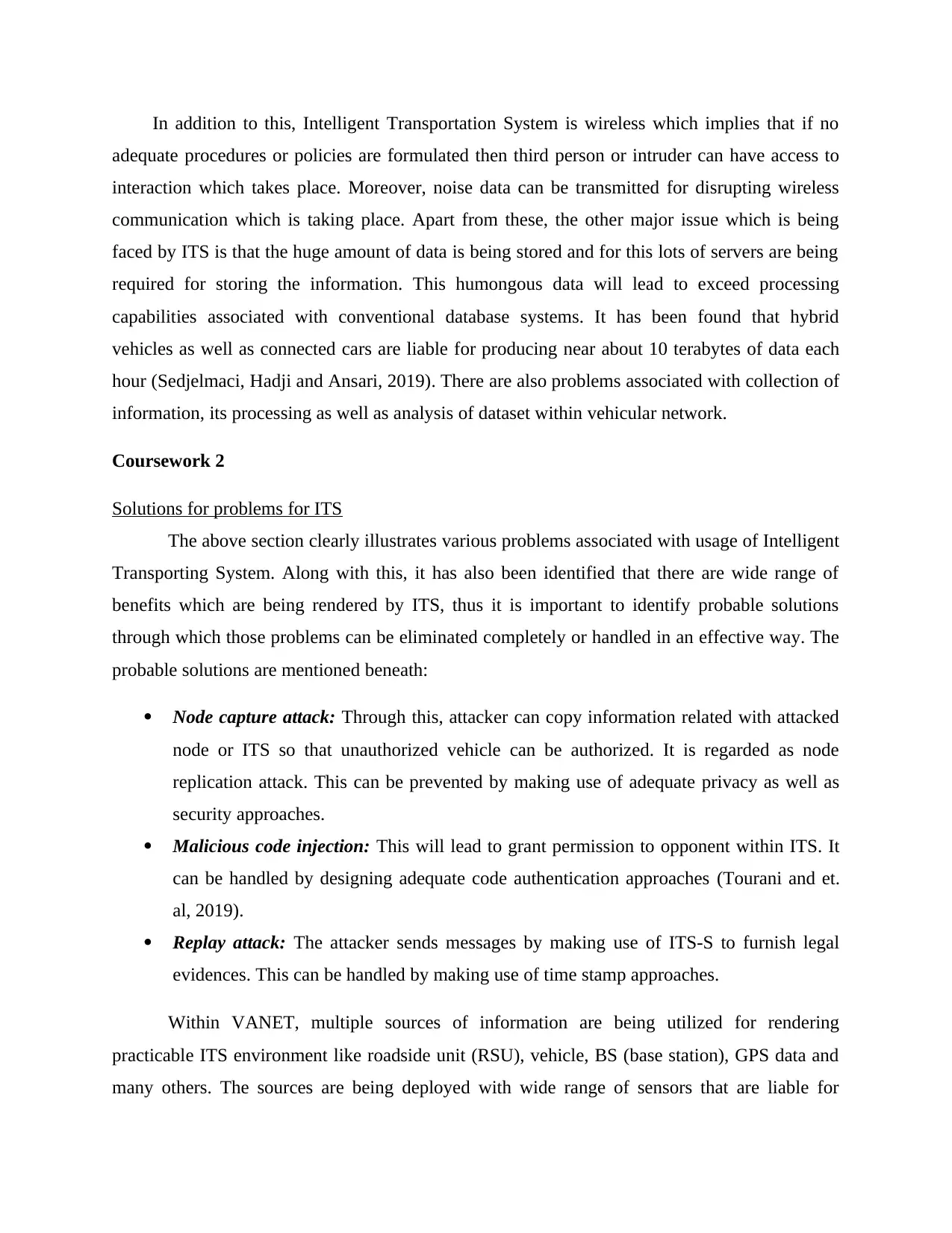
In addition to this, Intelligent Transportation System is wireless which implies that if no
adequate procedures or policies are formulated then third person or intruder can have access to
interaction which takes place. Moreover, noise data can be transmitted for disrupting wireless
communication which is taking place. Apart from these, the other major issue which is being
faced by ITS is that the huge amount of data is being stored and for this lots of servers are being
required for storing the information. This humongous data will lead to exceed processing
capabilities associated with conventional database systems. It has been found that hybrid
vehicles as well as connected cars are liable for producing near about 10 terabytes of data each
hour (Sedjelmaci, Hadji and Ansari, 2019). There are also problems associated with collection of
information, its processing as well as analysis of dataset within vehicular network.
Coursework 2
Solutions for problems for ITS
The above section clearly illustrates various problems associated with usage of Intelligent
Transporting System. Along with this, it has also been identified that there are wide range of
benefits which are being rendered by ITS, thus it is important to identify probable solutions
through which those problems can be eliminated completely or handled in an effective way. The
probable solutions are mentioned beneath:
Node capture attack: Through this, attacker can copy information related with attacked
node or ITS so that unauthorized vehicle can be authorized. It is regarded as node
replication attack. This can be prevented by making use of adequate privacy as well as
security approaches.
Malicious code injection: This will lead to grant permission to opponent within ITS. It
can be handled by designing adequate code authentication approaches (Tourani and et.
al, 2019).
Replay attack: The attacker sends messages by making use of ITS-S to furnish legal
evidences. This can be handled by making use of time stamp approaches.
Within VANET, multiple sources of information are being utilized for rendering
practicable ITS environment like roadside unit (RSU), vehicle, BS (base station), GPS data and
many others. The sources are being deployed with wide range of sensors that are liable for
adequate procedures or policies are formulated then third person or intruder can have access to
interaction which takes place. Moreover, noise data can be transmitted for disrupting wireless
communication which is taking place. Apart from these, the other major issue which is being
faced by ITS is that the huge amount of data is being stored and for this lots of servers are being
required for storing the information. This humongous data will lead to exceed processing
capabilities associated with conventional database systems. It has been found that hybrid
vehicles as well as connected cars are liable for producing near about 10 terabytes of data each
hour (Sedjelmaci, Hadji and Ansari, 2019). There are also problems associated with collection of
information, its processing as well as analysis of dataset within vehicular network.
Coursework 2
Solutions for problems for ITS
The above section clearly illustrates various problems associated with usage of Intelligent
Transporting System. Along with this, it has also been identified that there are wide range of
benefits which are being rendered by ITS, thus it is important to identify probable solutions
through which those problems can be eliminated completely or handled in an effective way. The
probable solutions are mentioned beneath:
Node capture attack: Through this, attacker can copy information related with attacked
node or ITS so that unauthorized vehicle can be authorized. It is regarded as node
replication attack. This can be prevented by making use of adequate privacy as well as
security approaches.
Malicious code injection: This will lead to grant permission to opponent within ITS. It
can be handled by designing adequate code authentication approaches (Tourani and et.
al, 2019).
Replay attack: The attacker sends messages by making use of ITS-S to furnish legal
evidences. This can be handled by making use of time stamp approaches.
Within VANET, multiple sources of information are being utilized for rendering
practicable ITS environment like roadside unit (RSU), vehicle, BS (base station), GPS data and
many others. The sources are being deployed with wide range of sensors that are liable for
Paraphrase This Document
Need a fresh take? Get an instant paraphrase of this document with our AI Paraphraser
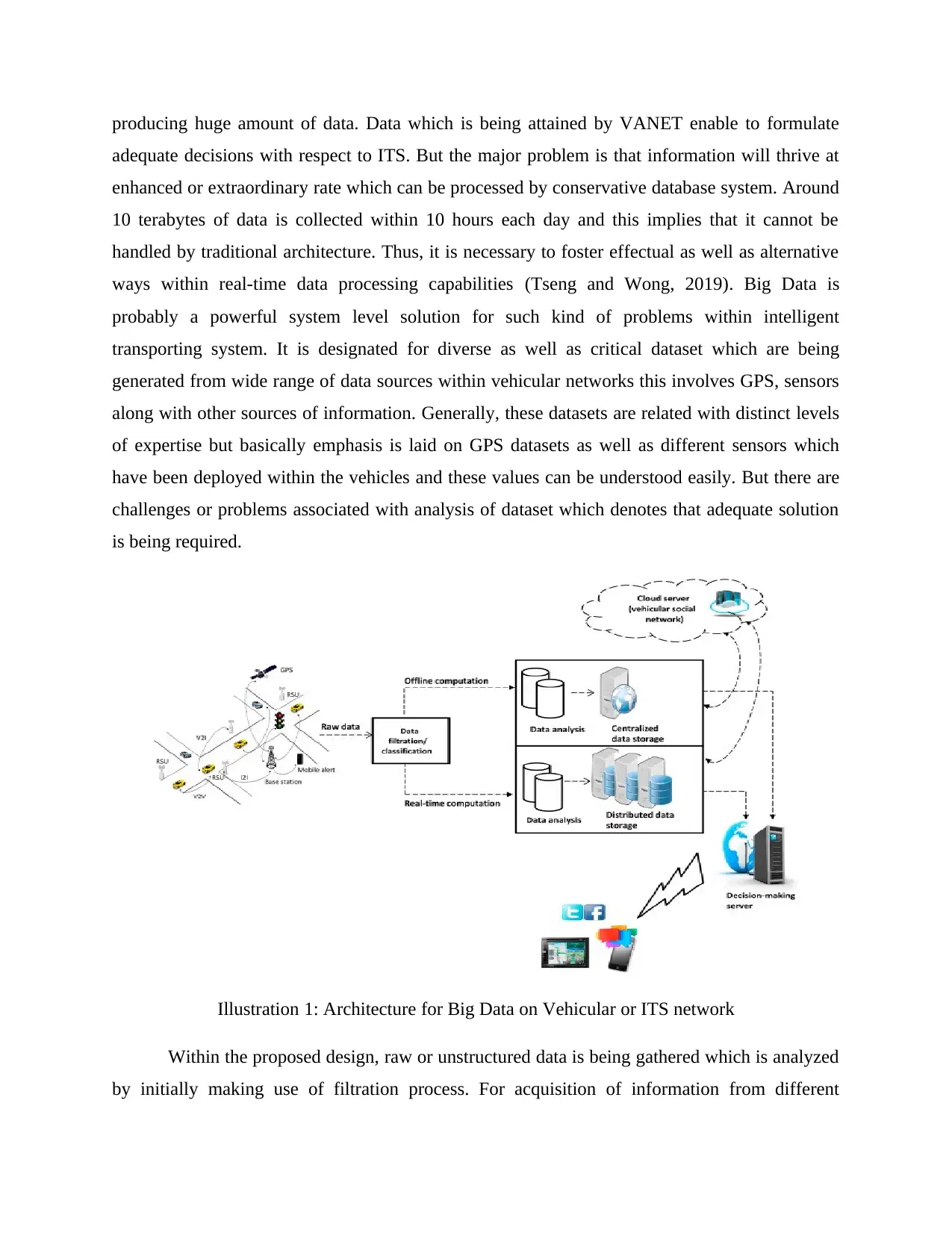
producing huge amount of data. Data which is being attained by VANET enable to formulate
adequate decisions with respect to ITS. But the major problem is that information will thrive at
enhanced or extraordinary rate which can be processed by conservative database system. Around
10 terabytes of data is collected within 10 hours each day and this implies that it cannot be
handled by traditional architecture. Thus, it is necessary to foster effectual as well as alternative
ways within real-time data processing capabilities (Tseng and Wong, 2019). Big Data is
probably a powerful system level solution for such kind of problems within intelligent
transporting system. It is designated for diverse as well as critical dataset which are being
generated from wide range of data sources within vehicular networks this involves GPS, sensors
along with other sources of information. Generally, these datasets are related with distinct levels
of expertise but basically emphasis is laid on GPS datasets as well as different sensors which
have been deployed within the vehicles and these values can be understood easily. But there are
challenges or problems associated with analysis of dataset which denotes that adequate solution
is being required.
Illustration 1: Architecture for Big Data on Vehicular or ITS network
Within the proposed design, raw or unstructured data is being gathered which is analyzed
by initially making use of filtration process. For acquisition of information from different
adequate decisions with respect to ITS. But the major problem is that information will thrive at
enhanced or extraordinary rate which can be processed by conservative database system. Around
10 terabytes of data is collected within 10 hours each day and this implies that it cannot be
handled by traditional architecture. Thus, it is necessary to foster effectual as well as alternative
ways within real-time data processing capabilities (Tseng and Wong, 2019). Big Data is
probably a powerful system level solution for such kind of problems within intelligent
transporting system. It is designated for diverse as well as critical dataset which are being
generated from wide range of data sources within vehicular networks this involves GPS, sensors
along with other sources of information. Generally, these datasets are related with distinct levels
of expertise but basically emphasis is laid on GPS datasets as well as different sensors which
have been deployed within the vehicles and these values can be understood easily. But there are
challenges or problems associated with analysis of dataset which denotes that adequate solution
is being required.
Illustration 1: Architecture for Big Data on Vehicular or ITS network
Within the proposed design, raw or unstructured data is being gathered which is analyzed
by initially making use of filtration process. For acquisition of information from different
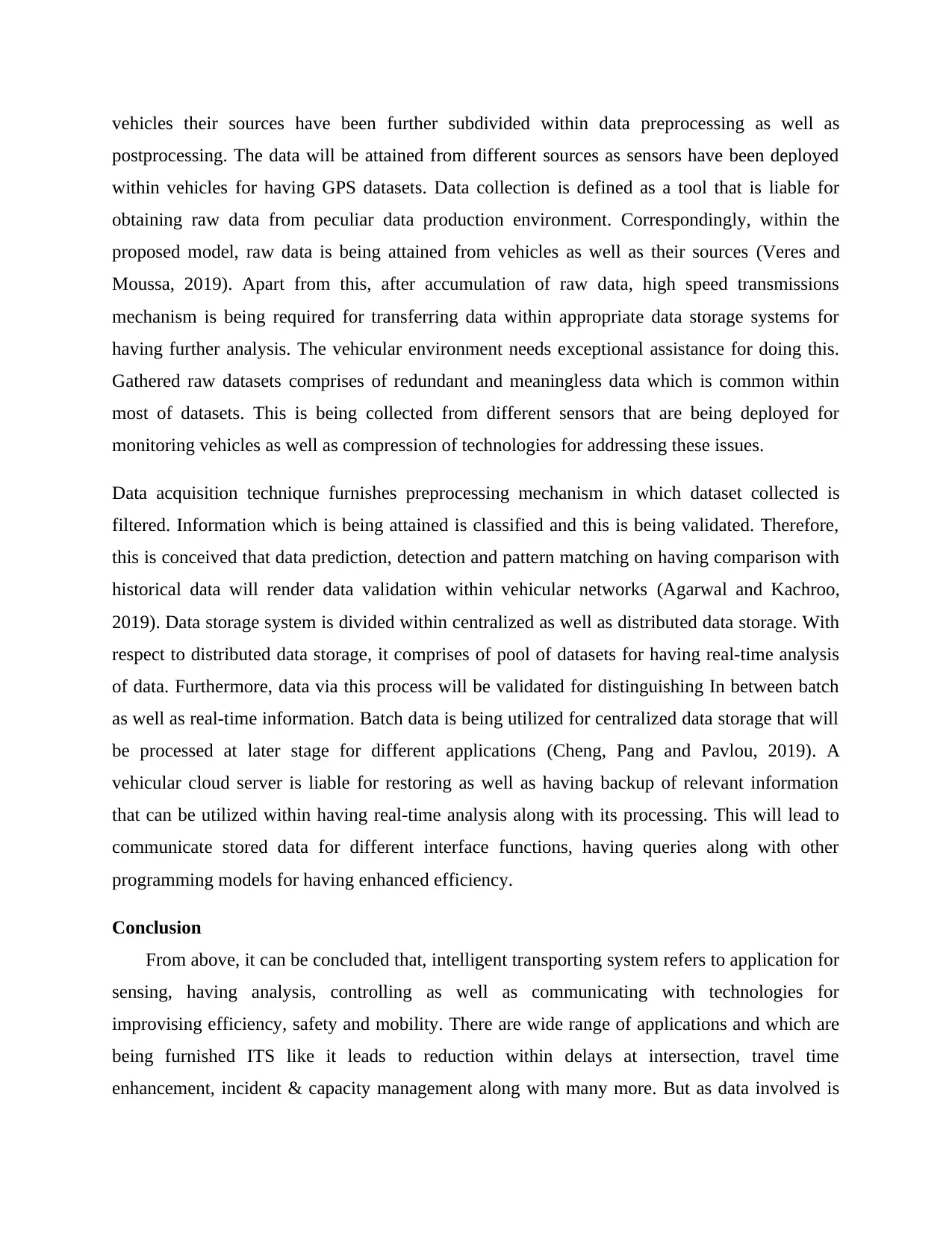
vehicles their sources have been further subdivided within data preprocessing as well as
postprocessing. The data will be attained from different sources as sensors have been deployed
within vehicles for having GPS datasets. Data collection is defined as a tool that is liable for
obtaining raw data from peculiar data production environment. Correspondingly, within the
proposed model, raw data is being attained from vehicles as well as their sources (Veres and
Moussa, 2019). Apart from this, after accumulation of raw data, high speed transmissions
mechanism is being required for transferring data within appropriate data storage systems for
having further analysis. The vehicular environment needs exceptional assistance for doing this.
Gathered raw datasets comprises of redundant and meaningless data which is common within
most of datasets. This is being collected from different sensors that are being deployed for
monitoring vehicles as well as compression of technologies for addressing these issues.
Data acquisition technique furnishes preprocessing mechanism in which dataset collected is
filtered. Information which is being attained is classified and this is being validated. Therefore,
this is conceived that data prediction, detection and pattern matching on having comparison with
historical data will render data validation within vehicular networks (Agarwal and Kachroo,
2019). Data storage system is divided within centralized as well as distributed data storage. With
respect to distributed data storage, it comprises of pool of datasets for having real-time analysis
of data. Furthermore, data via this process will be validated for distinguishing In between batch
as well as real-time information. Batch data is being utilized for centralized data storage that will
be processed at later stage for different applications (Cheng, Pang and Pavlou, 2019). A
vehicular cloud server is liable for restoring as well as having backup of relevant information
that can be utilized within having real-time analysis along with its processing. This will lead to
communicate stored data for different interface functions, having queries along with other
programming models for having enhanced efficiency.
Conclusion
From above, it can be concluded that, intelligent transporting system refers to application for
sensing, having analysis, controlling as well as communicating with technologies for
improvising efficiency, safety and mobility. There are wide range of applications and which are
being furnished ITS like it leads to reduction within delays at intersection, travel time
enhancement, incident & capacity management along with many more. But as data involved is
postprocessing. The data will be attained from different sources as sensors have been deployed
within vehicles for having GPS datasets. Data collection is defined as a tool that is liable for
obtaining raw data from peculiar data production environment. Correspondingly, within the
proposed model, raw data is being attained from vehicles as well as their sources (Veres and
Moussa, 2019). Apart from this, after accumulation of raw data, high speed transmissions
mechanism is being required for transferring data within appropriate data storage systems for
having further analysis. The vehicular environment needs exceptional assistance for doing this.
Gathered raw datasets comprises of redundant and meaningless data which is common within
most of datasets. This is being collected from different sensors that are being deployed for
monitoring vehicles as well as compression of technologies for addressing these issues.
Data acquisition technique furnishes preprocessing mechanism in which dataset collected is
filtered. Information which is being attained is classified and this is being validated. Therefore,
this is conceived that data prediction, detection and pattern matching on having comparison with
historical data will render data validation within vehicular networks (Agarwal and Kachroo,
2019). Data storage system is divided within centralized as well as distributed data storage. With
respect to distributed data storage, it comprises of pool of datasets for having real-time analysis
of data. Furthermore, data via this process will be validated for distinguishing In between batch
as well as real-time information. Batch data is being utilized for centralized data storage that will
be processed at later stage for different applications (Cheng, Pang and Pavlou, 2019). A
vehicular cloud server is liable for restoring as well as having backup of relevant information
that can be utilized within having real-time analysis along with its processing. This will lead to
communicate stored data for different interface functions, having queries along with other
programming models for having enhanced efficiency.
Conclusion
From above, it can be concluded that, intelligent transporting system refers to application for
sensing, having analysis, controlling as well as communicating with technologies for
improvising efficiency, safety and mobility. There are wide range of applications and which are
being furnished ITS like it leads to reduction within delays at intersection, travel time
enhancement, incident & capacity management along with many more. But as data involved is

more then it leads to issues related with security and privacy as well as storage and processing of
data. For this, big data and adequate security measures can be taken.
data. For this, big data and adequate security measures can be taken.
Secure Best Marks with AI Grader
Need help grading? Try our AI Grader for instant feedback on your assignments.
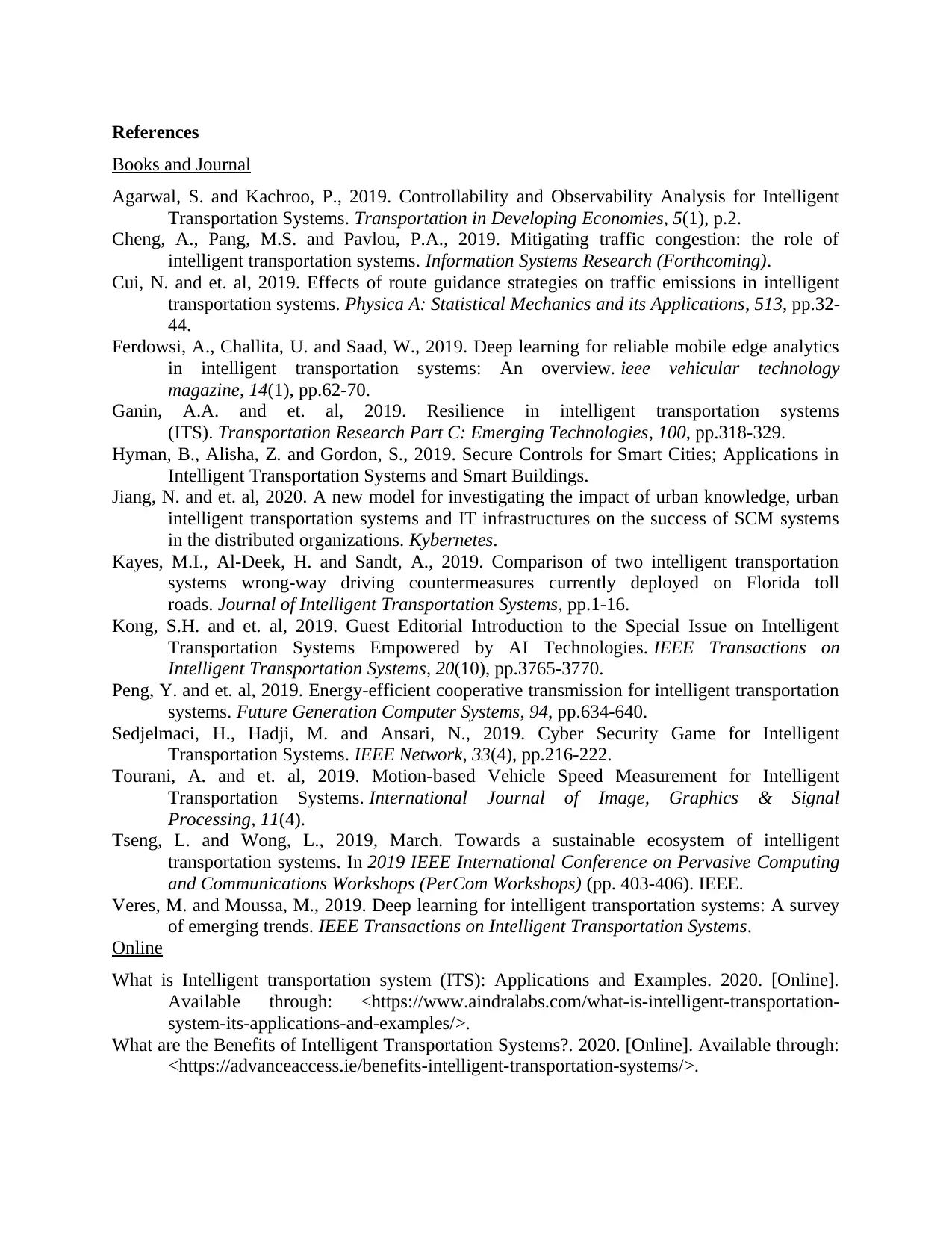
References
Books and Journal
Agarwal, S. and Kachroo, P., 2019. Controllability and Observability Analysis for Intelligent
Transportation Systems. Transportation in Developing Economies, 5(1), p.2.
Cheng, A., Pang, M.S. and Pavlou, P.A., 2019. Mitigating traffic congestion: the role of
intelligent transportation systems. Information Systems Research (Forthcoming).
Cui, N. and et. al, 2019. Effects of route guidance strategies on traffic emissions in intelligent
transportation systems. Physica A: Statistical Mechanics and its Applications, 513, pp.32-
44.
Ferdowsi, A., Challita, U. and Saad, W., 2019. Deep learning for reliable mobile edge analytics
in intelligent transportation systems: An overview. ieee vehicular technology
magazine, 14(1), pp.62-70.
Ganin, A.A. and et. al, 2019. Resilience in intelligent transportation systems
(ITS). Transportation Research Part C: Emerging Technologies, 100, pp.318-329.
Hyman, B., Alisha, Z. and Gordon, S., 2019. Secure Controls for Smart Cities; Applications in
Intelligent Transportation Systems and Smart Buildings.
Jiang, N. and et. al, 2020. A new model for investigating the impact of urban knowledge, urban
intelligent transportation systems and IT infrastructures on the success of SCM systems
in the distributed organizations. Kybernetes.
Kayes, M.I., Al-Deek, H. and Sandt, A., 2019. Comparison of two intelligent transportation
systems wrong-way driving countermeasures currently deployed on Florida toll
roads. Journal of Intelligent Transportation Systems, pp.1-16.
Kong, S.H. and et. al, 2019. Guest Editorial Introduction to the Special Issue on Intelligent
Transportation Systems Empowered by AI Technologies. IEEE Transactions on
Intelligent Transportation Systems, 20(10), pp.3765-3770.
Peng, Y. and et. al, 2019. Energy-efficient cooperative transmission for intelligent transportation
systems. Future Generation Computer Systems, 94, pp.634-640.
Sedjelmaci, H., Hadji, M. and Ansari, N., 2019. Cyber Security Game for Intelligent
Transportation Systems. IEEE Network, 33(4), pp.216-222.
Tourani, A. and et. al, 2019. Motion-based Vehicle Speed Measurement for Intelligent
Transportation Systems. International Journal of Image, Graphics & Signal
Processing, 11(4).
Tseng, L. and Wong, L., 2019, March. Towards a sustainable ecosystem of intelligent
transportation systems. In 2019 IEEE International Conference on Pervasive Computing
and Communications Workshops (PerCom Workshops) (pp. 403-406). IEEE.
Veres, M. and Moussa, M., 2019. Deep learning for intelligent transportation systems: A survey
of emerging trends. IEEE Transactions on Intelligent Transportation Systems.
Online
What is Intelligent transportation system (ITS): Applications and Examples. 2020. [Online].
Available through: <https://www.aindralabs.com/what-is-intelligent-transportation-
system-its-applications-and-examples/>.
What are the Benefits of Intelligent Transportation Systems?. 2020. [Online]. Available through:
<https://advanceaccess.ie/benefits-intelligent-transportation-systems/>.
Books and Journal
Agarwal, S. and Kachroo, P., 2019. Controllability and Observability Analysis for Intelligent
Transportation Systems. Transportation in Developing Economies, 5(1), p.2.
Cheng, A., Pang, M.S. and Pavlou, P.A., 2019. Mitigating traffic congestion: the role of
intelligent transportation systems. Information Systems Research (Forthcoming).
Cui, N. and et. al, 2019. Effects of route guidance strategies on traffic emissions in intelligent
transportation systems. Physica A: Statistical Mechanics and its Applications, 513, pp.32-
44.
Ferdowsi, A., Challita, U. and Saad, W., 2019. Deep learning for reliable mobile edge analytics
in intelligent transportation systems: An overview. ieee vehicular technology
magazine, 14(1), pp.62-70.
Ganin, A.A. and et. al, 2019. Resilience in intelligent transportation systems
(ITS). Transportation Research Part C: Emerging Technologies, 100, pp.318-329.
Hyman, B., Alisha, Z. and Gordon, S., 2019. Secure Controls for Smart Cities; Applications in
Intelligent Transportation Systems and Smart Buildings.
Jiang, N. and et. al, 2020. A new model for investigating the impact of urban knowledge, urban
intelligent transportation systems and IT infrastructures on the success of SCM systems
in the distributed organizations. Kybernetes.
Kayes, M.I., Al-Deek, H. and Sandt, A., 2019. Comparison of two intelligent transportation
systems wrong-way driving countermeasures currently deployed on Florida toll
roads. Journal of Intelligent Transportation Systems, pp.1-16.
Kong, S.H. and et. al, 2019. Guest Editorial Introduction to the Special Issue on Intelligent
Transportation Systems Empowered by AI Technologies. IEEE Transactions on
Intelligent Transportation Systems, 20(10), pp.3765-3770.
Peng, Y. and et. al, 2019. Energy-efficient cooperative transmission for intelligent transportation
systems. Future Generation Computer Systems, 94, pp.634-640.
Sedjelmaci, H., Hadji, M. and Ansari, N., 2019. Cyber Security Game for Intelligent
Transportation Systems. IEEE Network, 33(4), pp.216-222.
Tourani, A. and et. al, 2019. Motion-based Vehicle Speed Measurement for Intelligent
Transportation Systems. International Journal of Image, Graphics & Signal
Processing, 11(4).
Tseng, L. and Wong, L., 2019, March. Towards a sustainable ecosystem of intelligent
transportation systems. In 2019 IEEE International Conference on Pervasive Computing
and Communications Workshops (PerCom Workshops) (pp. 403-406). IEEE.
Veres, M. and Moussa, M., 2019. Deep learning for intelligent transportation systems: A survey
of emerging trends. IEEE Transactions on Intelligent Transportation Systems.
Online
What is Intelligent transportation system (ITS): Applications and Examples. 2020. [Online].
Available through: <https://www.aindralabs.com/what-is-intelligent-transportation-
system-its-applications-and-examples/>.
What are the Benefits of Intelligent Transportation Systems?. 2020. [Online]. Available through:
<https://advanceaccess.ie/benefits-intelligent-transportation-systems/>.
1 out of 11
Related Documents
Your All-in-One AI-Powered Toolkit for Academic Success.
+13062052269
info@desklib.com
Available 24*7 on WhatsApp / Email
![[object Object]](/_next/static/media/star-bottom.7253800d.svg)
Unlock your academic potential
© 2024 | Zucol Services PVT LTD | All rights reserved.





